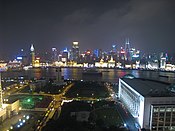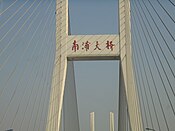Puxi

Puxi (Chinese: 浦西, p Pǔxī, Shanghainese Pu上-xi平, lit "Huangpu West Bank") is the historic center of Shanghai, China, and remains the home of approximately 48% of Shanghai's residents in an area of 288 km².[1] Puxi is distinguished from Pudong to its east, which is separated from it by the Huangpu River. Despite the growing importance of Pudong's Lujiazui area, Puxi remains Shanghai's cultural, residential and commercial centre.
Administratively, Puxi consists of a number of districts including Yangpu, Hongkou, Putuo, Changning, Xuhui, Jing'an and Huangpu.
Culture and Entertainment
Despite efforts to promote Pudong, Puxi remains the cultural and entertainment center of Shanghai. The main shopping centers (including East Nanjing Pedestrian Road, Central Huaihai Road, Qipu Road Apparel City, and Xujiahui), the major bar streets (Hengshan, Maoming, and Julu Roads), and cultural centers such as The Bund, the Shanghai Grand Theatre, and the Shanghai Museum are all located in Puxi.
Transportation
Shanghai's older airport, Shanghai Hongqiao International Airport, is located in Puxi. All international flights, including regional flights to Hong Kong and Macao, were moved to Shanghai Pudong International Airport when the latter opened in 1999. From October 2007, a limited number of international flights will commence from Hongqiao.[2]
Almost all lines on the Shanghai Metro (with the exceptions of Lines 5 and 6) pass by Puxi.
Pudong and Puxi are connected by several tunnels, four major bridges, and Lines 2, 4, 7, 8 and 9 on the Shanghai Metro.
The Shanghai Railway Station and Shanghai South Railway Station are also located in Puxi.
-
A view of the Puxi skyline, across the river from Pudong
-
The Nanpu Bridge which connects Puxi with Pudong
-
Puxi at night
-
Puxi in morning
-
Complex viaducts in Puxi (Nanbei Elevated Road at Yanan Middle Road)





